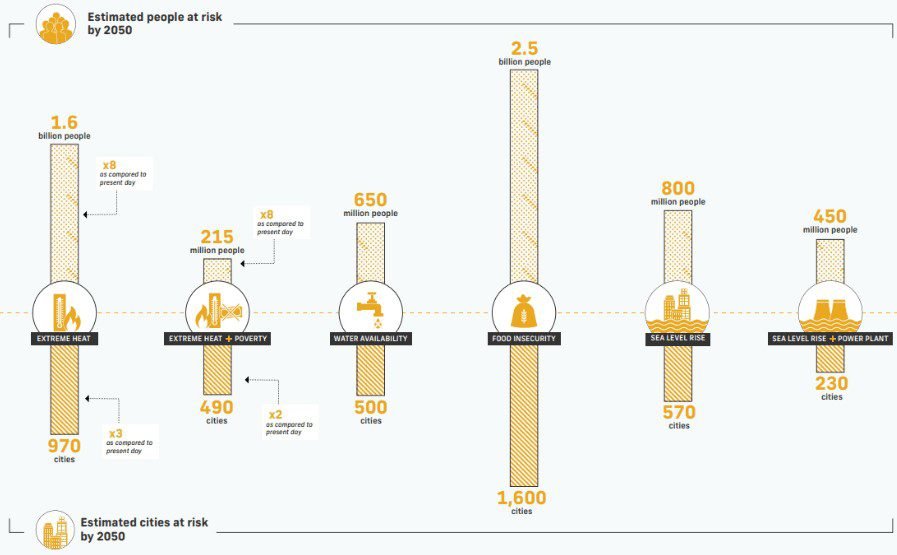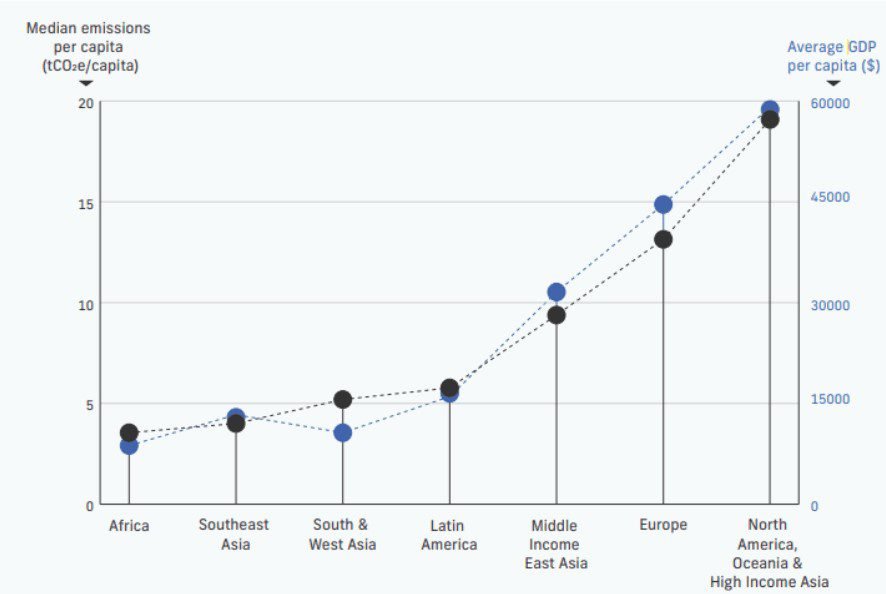Yes, you read that right, today we want to talk about climate change and how likely or unlikely new lockdowns could happen, this time, due to the -in the words of the media and governments- terrible climate crisis we find ourselves in.
After the wonderful experience of months of being locked in our homes during COVID-19, governments are so delighted with the experience that they are considering repeating it, but this time to protect the ‘climate’ (who knows what they mean by climate here…)
The media often talk about climate change. When someone talks about climate change, they mean the cooling or warming of the earth’s climate over an extended period of time, i.e. the long-term change in conditions such as temperature, precipitation or ocean currents. When the media talk about climate change, they really mean global warming, which is one particular example of the consequences of climate change.
This is one of the most recurring themes for politicians, who use it as a pretext for intervention and paternalism. Of course, it is also used by numerous institutions and associations and even scientists and so-called experts, who see climate change as their golden goose. A whole generation, with the consent of the government and partly supported by parents, spreads fear in schools, i.e. in the system of forced school indoctrination (from which, by the way, you should try to get your children out of as soon as possible), or threatens the lifestyle of others with sit-ins and demonstrations.
Why is there so much talk in the media about climate change?
Not a day can go by without climate change being discussed in some way in the media. On the one hand, we have the political debates about bills that presumably aim to counteract climate change. On the other hand, we are often informed about catastrophic climate scenarios that will hit us in the future or are already hitting us – as was the case years ago with the coronavirus. The message is clear: we ‘need’ the government to protect us like a superhero from enemies (including invisible ones) and from the disasters we ourselves cause.
We have already found one or two reasons why climate change is reported so insistently. Naturally, it is easier for politicians to pass administrative decisions (such as the CO2 tax) if fear is constantly instilled in people. I am sure you are familiar with this strategy: remember the newspaper articles last winter saying that the whole world would freeze and the economy would collapse because of the energy crisis? Fear, fear, fear, and sensationalist manipulation.
The second reason is, of course, ‘education and spreading of information’ (indoctrination one might say), which is the main task of journalism. Whether the information is correct or not is a moot point —and, in any case, it is another matter that does not concern them.
However, to get to the heart of the matter, we first need to clarify what exactly climate change is. To this end, we will examine both the causes and consequences of this phenomenon throughout this article.
What are the causes of climate change?
The main cause of climate change is thought to be the greenhouse effect. Some gases in Earth’s atmosphere act in a similar way to the glass in a greenhouse: although the sun’s heat can enter, the gases prevent it from radiating back into space, causing the earth to warm up.
Many of these greenhouse gases are natural components of Earth’s atmosphere. The concentration of some of these gases has increased due to human activities or urban consumption of, for example, building materials, food, clothing and textiles, private transport, electronics, household appliances, and private aviation. This consumption and activity specifically increase the following gases:
- Carbon dioxide (CO2)
- Methane
- Nitrous oxide
- Fluorinated gases
However, there are also natural causes of climate change —as we have already mentioned, climate change is not a new phenomenon. The climate fluctuates constantly and never remains stable. Natural climate variability can be affected by solar radiation, dust and sulphur from large volcanic eruptions, meteorite impacts and changes in Earth’s orbit over time. However, according to the report ‘The Future of Urban Consumption in a 1.5ºC World’, urban consumption is one of the main drivers of global greenhouse gas emissions.
However, more and more scientists are opposing this mainstream. If you are interested, you can analyse the myth of man-made climate change yourself with the help of the following studies. Did you know that since 1750, only 23% of man-made CO2 has reached the atmosphere?
- Skrable, K., Chabot, G. and French, C. (2022). World atmospheric CO2, its 14C specific activity, non-fossil component, anthropogenic fossil component, and emissions (1750-2018). Health Physics, 122(2), pp.291-305.
- Frank, P. (2019). Propagation of error and the reliability of global air temperature projections. Frontiers in Earth Science, 7, p.223.
- Dagsvik, John K. and Moen, Sigmund H. (2023). To what extent are temperature levels changing due to greenhouse gas emissions? Statistics Norway, Discussion Paper Series #1007.
- O’Neill, P., Connolly, R., Connolly, M., Soon, W., Chimani, B., Crok, M., de Vos, R., Harde, H., Kajaba, P., Nojarov, P. and Przybylak, R. (2022). Evaluation of the homogenization adjustments applied to European temperature records in the Global Historical Climatology Network Dataset. Atmosphere 13(2), p.285.
- Seo, Ki-Weon, Dongryeol Ryu, Jooyoung Eom, Taewhan Jeon, Jae-Seung Kim, Kookhyoun Youm, Jianli Chen, and Clark R. Wilson (2023). Drift of Earth’s pole confirms groundwater depletion as a significant contributor to global sea level rise 1993-2010. Geophysical Research Letters 50(12): e2023GL103509.
- Petit, Jean-Robert, Jean Jouzel, Dominique Raynaud, Narcisse I. Barkov, J-M. Barnola, Isabelle Basile, Michael Bender et al. (1999). Climate and atmospheric history of the past 420,000 years from the Vostok ice core, Antarctica. Nature 399(6735): pp.429-436.
- Munshi, Jamal (2018). Uncertainty in empirical Climate Sensitivity Estimates 1850 – 2017.
What are the consequences of climate change?
The media often dwell on the consequences of climate change, so you will probably be able to answer this question yourself. To refresh your memory, a few examples: When discussing climate change, the extinction of species, the increase in the number and intensity of adverse weather events (such as cold and heat waves, droughts, hurricanes, floods and forest fires) and the melting of glaciers are often mentioned.
 In addition, there are other consequences such as extreme heat, food insecurity and water scarcity, which mainly affect urban dwellers (as illustrated in the graph above). This image is part of a report whose vision we do not share at all (to understand our perspective you can consult any of the studies we have provided you with) but, to better illustrate it all, we will adopt the mainstream thinking on climate change.
In addition, there are other consequences such as extreme heat, food insecurity and water scarcity, which mainly affect urban dwellers (as illustrated in the graph above). This image is part of a report whose vision we do not share at all (to understand our perspective you can consult any of the studies we have provided you with) but, to better illustrate it all, we will adopt the mainstream thinking on climate change.
You can take a look at such studies, for example here.
Brave New World (at 1.5°C)
Measures to reduce the impact of urban consumption in line with limiting global warming to 1.5°C are also in place. This 1.5°C comes from the Paris Agreement, which stated that the annual global temperature increase should be limited to 1.5°C wherever possible (in any case well below 2°C, compared to the pre-industrial era). In 2018, the Intergovernmental Panel on Climate Change (IPCC) published a special report on global warming, which shows that an average annual warming of 1.5 °C is the only feasible goal for maintaining a liveable global environment.
Urban consumption as the main driver
As mentioned above, urban consumption is the main driver of greenhouse gas emissions, but why is urban consumption the main culprit? Because consumption-based emissions add up to a total climate impact that is about 60% higher than production-based emissions. Consumption-based emissions are the sum of all emissions that accumulate from the extraction of raw materials to production, transport, consumption itself and disposal of the resulting waste.
In the case of clothing, for example, emissions generated during washing are also considered. In contrast to the production-based approach, which is currently the norm, emissions from activities outside geographical boundaries are also considered in this way. In addition, a correlation has been established between GDP (Gross Domestic Product, a measure of the value of domestically produced goods and services) and the average value of carbon emissions per capita consumption. This means that the higher the GDP, the higher the emission per capita consumption, as shown in the graph below:
 What is the solution to this problem?
What is the solution to this problem?
To avoid climate collapse, “emissions from urban consumption must be halved by 2030”. To achieve this, carbon emissions from consumption in high-income cities must be reduced by two-thirds over the next decade. But why high-income cities and not others? As mentioned above, a correlation has been established between GDP and per capita consumption emissions. Countries with high GDP tend to have comparatively high incomes as well. In addition, rapidly developing economies will need to adopt sustainable consumption patterns as they grow.
The following table details the measures that “need to be taken”:
| Category | Consumption interventions | Emission reductions by category between 2017 and 2030 | Emission reductions by category between 2017 and 2050 |
| Clothing | Reducing the number of new items manufactured and reducing waste in the supply chain | 39%
(37% is attributable to the reduction in the number of new clothes alone) |
66%
(64% is attributable to the reduction in the number of new clothes alone) |
| Food | Dietary change: eating according to health recommendations and reducing both meat and dairy consumption in general:
– Reduction of household waste – Reduction of waste in the supply chain |
36% (27% is attributable to the dietary change alone) | 60% (45% is attributable to the dietary change alone)
|
| Traveling | Reduction in the number of flights, introduction of sustainable fuels in aviation | 26% (18% is attributable to the reductions of flights alone) | 55% (31% is attributable to the reductions of flights alone) |
| Housing | Improving the efficiency of materials and use of buildings. Transition to low carbon materials (e.g. low-carbon cement), reuse of building components… | 26% (18% is attributable to the improvement of material efficiency & building utilization) | 44% (29% is attributable to the improvement of material efficiency & building utilization) |
| Vehicles | Reducing the number of cars and increasing both the lifetime of vehicles and the efficiency of materials | 28% (24% is attributable to the reduction in car ownership alone) | 39% (31% is attributable to the reduction in car ownership alone) |
| Information Technology
(IT) |
Optimizing the lifetime of IT devices | 18% | 33% |
Much of this depends on individual people, but the individual cannot change the way the global economy works. That is why mayors, communities, and cities in general, businesses and individual consumers must work together. At least this is what the report says.
CO2 taxes, as already introduced by many governments (EU-wide, UK, Canada…), are not proposed.
Climate lockdowns as a measure to implement interventions
Unfortunately, these discoveries and those that became apparent during the coronavirus confinement inspired among politicians the idea of imposed lockdowns for environmental reasons. Scientist Mariana Mazzucato shares this view, which she expressed in an article for Project Syndicate: “In the near future, the world may need to resort to lockdowns again – this time to tackle a climate emergency […] Under a ‘climate lockdown,’ governments would limit private-vehicle use, ban consumption of red meat, and impose extreme energy-saving measures, while fossil-fuel companies would have to stop drilling.”
Anyone who thinks this is just another conspiracy fantasy is probably unaware that restrictions on freedom of movement already exist in many countries in and outside Europe —like Spain, for example. It is known as the ‘Low Emission Zone’.
In case you are lucky enough not to know what we are talking about, Low Emission Zones are designated areas in cities where access to the most polluting vehicles (or the vehicles of people who do not live there) is restricted in order to improve air quality.
In Germany, Health Minister Karl Lauterbach (Socialist Party) presented his action plan for “health protection against heat” in June 2023. The core of Lauterbach’s plan is ‘education’. Poster campaigns will be launched and a kind of warning concept will be developed. The author, Reitschuster, also speaks of the return of restrictions on public life and personal freedom in this context.
In addition, some 100 cities have already formed a coalition called the “C40 Cities Climate Leadership Group” (or C40 for short). It is often difficult to establish with certainty whether this movement is real or not, as the media often indulge in sensationalism. Some claim it is a lie, while others claim it is real. What we do know for sure is that politicians often put ideas in the media and, if these ideas get a favourable response from citizens, they may end up implementing them —and, if the response is negative, they label it as fake news and call it a day.
Maybe their aim is to attract attention.
These cities want to achieve the Global Goals and the 2030 Agenda for Sustainable Development and, to do so, have committed to introducing the following rules for their residents:
- 0 kg meat consumption
- 0 kg consumption of dairy products
- 3 new items of clothing per person per year
- 0 privately owned vehicles
- 1 short-haul flight (less than 1500 km) per person per 3 years
The head of the organisation is Michael Bloomberg, who is also responsible for most of the funding. You can find a short excerpt from the list of C40 countries below. Particularly striking is the very high proportion of European cities:
- Aarhus (Denmark)
- Alenzon (France)
- Amsterdam (The Netherlands)
- Barcelona (Spain)
- Belfast (United Kingdom)
- Bergen (Norway)
- Berlin (Germany)
- Bonn (Germany)
- Brașov (Romania)
- Budapest (Hungary)
- London (United Kingdom)
- Essen (Germany)
- Florence (Italy)
- Frankfurt (Germany)
- Geneva (Switzerland)
- Gütersloh (Germany)
- Hamburg (Germany)
- Hannover (Germany)
- Heidelberg (Germany)
- Helsingborg (Sweden)
- Helsinki (Finland)
- Ittre (Belgium)
- Konstanz (Germany)
- Krakow (Poland)
- Lausanne (Switzerland)
- Lisbon (Portugal)
- Ljubljana (Slovenia)
- Łódź (Poland)
- Madrid (Spain)
- Milan (Italy)
- Munich (Germany)
- Münster (Germany)
- Nové Město na Moravě (Czech Republic)
- Oslo (Norway)
- Paris (France)
- Pforzheim (Germany)
- Prague (Czech Republic)
- Reykjavík (Iceland)
- Riga (Latvia)
- Ruse (Bulgaria)
- Speyer (Germany)
- Stockholm (Sweden)
- Vienna (Austria)
- Warsaw (Poland)
- Zurich (Switzerland)
In case you were wondering, all these measures will most likely be tracked and controlled by CBDC digital currencies.
The amazing thing is that people will just accept it and consider it normal – or even fair and necessary.
And if you want to defend your freedom and prevent it from being subjugated by a group of people who claim the power to decide for everyone, you automatically become a genocidal ‘enemy of society’ in their eyes. They will accuse you of wanting people to die from a virus or climate change, and they will claim that you want to destroy the world. Of course! The truth is that once a country’s population is brainwashed, it is very difficult to reverse the process – this goes far beyond ‘every man for himself.’
The first restrictions are already in force
Many people do not know it, but in May 2021 the German Federal Cabinet passed the Climate Law. With this law, Germany has set itself ambitious goals, which focus on reducing greenhouse gas emissions. More specifically, Germany aims with this law to reduce its greenhouse gas emissions to almost 0% by 2045 – these measures use 1990 levels as a point of comparison. The CO2 emissions tax is also derived from this law. Another statement of the Federal Constitutional Court indicates that climate protection legislation is indeed allowed to fundamentally restrict the freedom of Germans.
As we know, this is how things work in the European Union: Germany introduces new laws and then they are extended by means of directives to the other countries.
By the way, another thing we have learned today is how taxes are ‘created’:
- You choose or invent a problem.
- You build a story around that problem
- You fear-bomb people
- You present yourself as the saviour of the nation and propose to solve the problem.
- You create a movement that roots in the culture of the people and in public ideology
- You brainwash a section of the population to act as a small corps of soldiers defending your idea.
- You tax the whole population to appropriate their property, and you threaten with fines, penalties, and imprisonment those who defy you and do not do what you want them to do.
- You claim that taxes are a contribution to society.
- You turn people into handcuffed, gagged, and blindfolded puppets of the state.
Even so, many will continue to argue that anyone who does not pay taxes is a ‘bad person’, but the truth is that most people do not stop to think about what those taxes actually finance. The truth is that, through taxes, governments not only steal your money, but also your freedom.
Climate lockdowns in other countries
There have already been climate lockdowns in other countries, such as the one in Delhi (India) in November 2021, for example. On that occasion, the inhabitants of the Indian capital did not stay at home teleworking because of the coronavirus pandemic, but because of the health emergency declared by the government due to high levels of air pollution. Indian doctors have warned that breathing in Delhi for a day is as bad as smoking 20 cigarettes. Schools also remained closed and construction sites were at a standstill. Bustling Delhi looked like a ghost town.
Would confinement really help to combat climate change?
According to Professor Le Quéré’s study, during the coronavirus lockdown, there was a temporary global reduction in CO2 emissions of up to one-sixth compared to the previous year. Some countries even achieved an average reduction of around 26%. According to the researchers, this was due to measures taken by governments. More specifically, lower energy demand, a reduction in industry and a reduction in transport had the greatest impact on the global climate.
An example of this can be seen on 7 April 2020. On that day, restrictions were particularly severe worldwide, and CO2 emissions from air traffic fell by 60% compared to the average value for 2019. In China alone, around 242 megatonnes of CO2 were saved from January to April 2020 —Europe, with 123 megatonnes, saved just over half as much as China. By comparison, European air traffic emitted 163 megatonnes of CO2 in 2019.
Despite all this, Professor Le Quéré does not consider climate containment to be a long-term solution, as the measures are only temporary…
The truth is that Earth has warmed and cooled constantly over the last few centuries. Humans could not have been the main cause of this phenomenon. It must be some other agent that has caused these global temperature changes. Perhaps this phenomenon is the main cause of the global warming we are currently experiencing, although we cannot identify it. The key is that we need to identify the main anthropogenic cause of global warming (assuming it really exists) before we can decide how to act.
If you want a new perspective on all the fallacies being told and taught about the environment and climate change, we encourage you to take a look here: a valuable new perspective on how to deal with the problem in the fairest and most effective way without limiting, restricting or attacking your freedoms or anyone else’s —nor your property. Stop listening to those who just want to drown you in taxes without caring at all about your opinion and freedom.
And if you want to take the leap and live a life that is truly yours without the threat of future lockdowns, contact us.
Did you like our blog article?
Support us by purchasing our products and services. Or build up a passive income by recommending us as an affiliate! And don't forget to check out Christoph's travel blog christoph.today!
Secret Knowledge Video Course
Learn Everything that You Need to Know for a Life as a Perpetual Traveler
Watch Video CourseEncyclopedia Collection
Acquire Expansive Knowledge about Banking, Companies, Citizenships, and Emigration.
Order eBooks

 What is the solution to this problem?
What is the solution to this problem?




